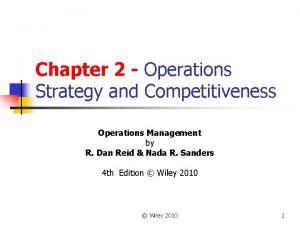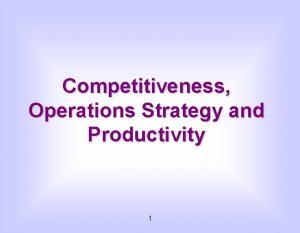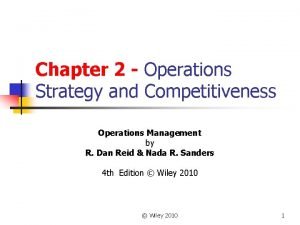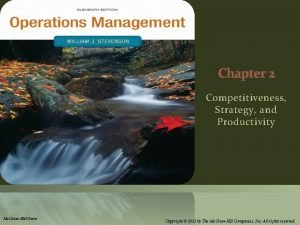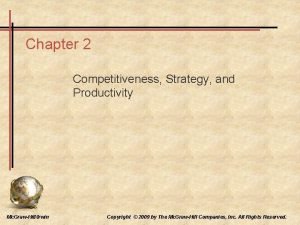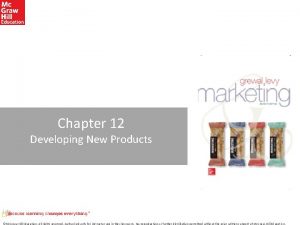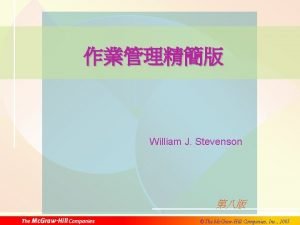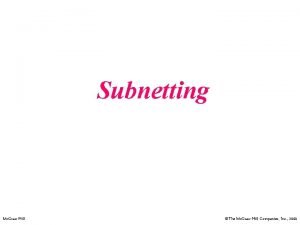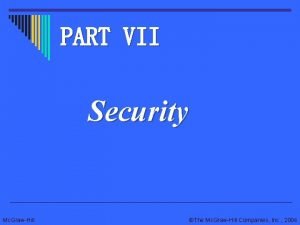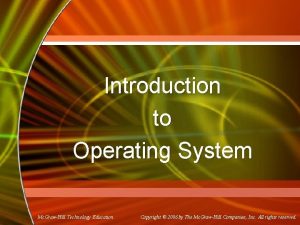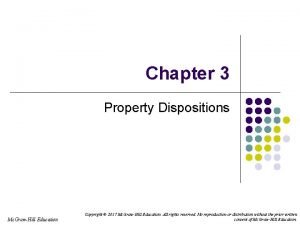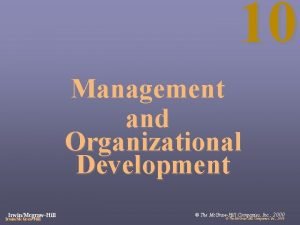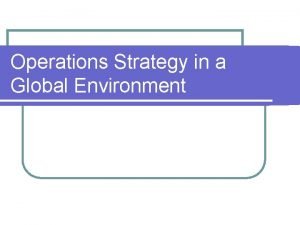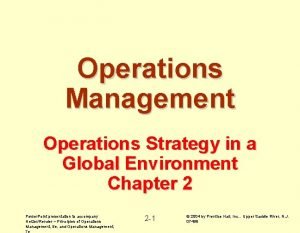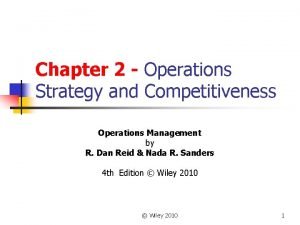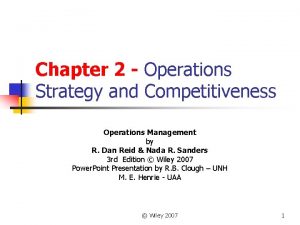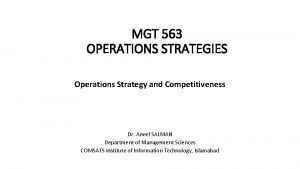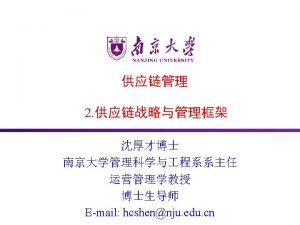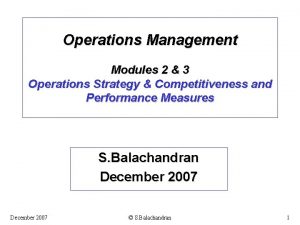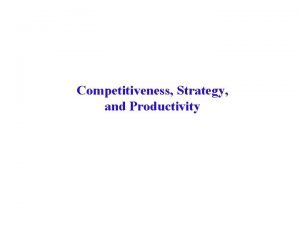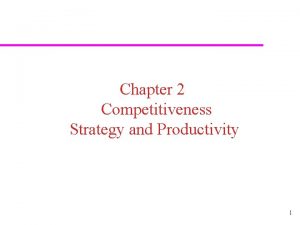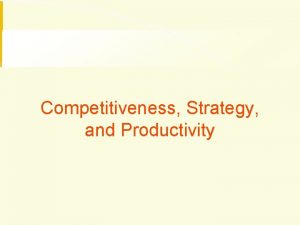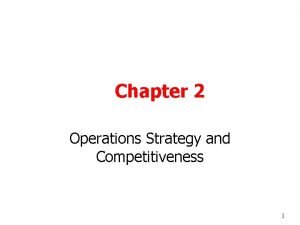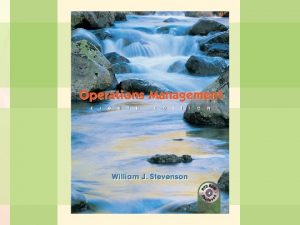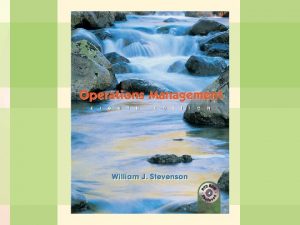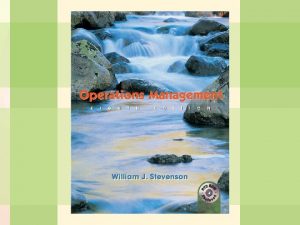1 Operations Strategy and Competitiveness The Mc GrawHill




















- Slides: 20

1 Operations Strategy and Competitiveness ©The Mc. Graw-Hill Companies, Inc. , 2004

2 OBJECTIVES • Operations Strategy • Competitive Dimensions • Order Qualifiers and Winners • Strategy Design Process • A Framework for Manufacturing Strategy • Service Strategy Capacity Capabilities • Productivity Measures ©The Mc. Graw-Hill Companies, Inc. , 2004

3 Operations Strategy Process Example Customer Needs More Product Corporate Strategy Increase Org. Size Operations Strategy Decisions on Processes and Infrastructure Increase Production Capacity Build New Factory ©The Mc. Graw-Hill Companies, Inc. , 2004

4 Competitive Dimensions • • • Cost Product Quality and Reliability Delivery Speed Delivery Reliability Coping with Changes in Demand Flexibility and New Product Introduction Speed • Other Product-Specific Criteria ©The Mc. Graw-Hill Companies, Inc. , 2004

5 Dealing with Trade-offs For example, if we reduce costs by reducing product quality inspections, we might reduce product quality. For example, if we improve customer service problem solving by cross-training personnel to deal with a wider-range of problems, they may become less efficient at dealing with commonly occurring problems. Cost Flexibility Delivery Quality ©The Mc. Graw-Hill Companies, Inc. , 2004

6 Order Qualifiers and Winners Defined • Order qualifiers are the basic criteria that permit the firms products to be considered as candidates for purchase by customers • Order winners are the criteria that differentiates the products and services of one firm from another ©The Mc. Graw-Hill Companies, Inc. , 2004

7 Service Breakthroughs • A brand name car can be an “order qualifier” · Repair services can be “order winners” Examples: Warranty, Roadside Assistance, Leases, etc ©The Mc. Graw-Hill Companies, Inc. , 2004

8 Strategy Design Process Strategy Map What it is about! Financial Perspective Improve Shareholder Value Customer Perspective Customer Value Proposition Internal Perspective Build-Increase-Achieve Learning and Growth Perspective A Motivated and Prepared Workforce ©The Mc. Graw-Hill Companies, Inc. , 2004

9 Kaplan and Norton’s Generic Strategy Map In the Kaplan and Norton’s Generic Strategy Map, under the Financial Perspective, the Productivity Strategy is generally made up from two components: 1. Improve cost structure: Lower direct and indirect costs 2. Increase asset utilization: Reduce working and fixed capital ©The Mc. Graw-Hill Companies, Inc. , 2004

10 Kaplan and Norton’s Generic Strategy Map (Continued) In the Kaplan and Norton’s Generic Strategy Map, under the Financial Perspective, the Revenue Growth Strategy is generally made up from two components: 1. Build the franchise: Develop new sources of revenue 2. Increase customer value: Work with existing customers to expand relationships with company ©The Mc. Graw-Hill Companies, Inc. , 2004

11 Kaplan and Norton’s Generic Strategy Map (Continued) In the Kaplan and Norton’s Generic Strategy Map, under the Customer Perspective, there are three ways suggested as means of differentiating a company from others in a marketplace: 1. Product leadership 2. Customer intimacy 3. Operational excellence ©The Mc. Graw-Hill Companies, Inc. , 2004

12 Kaplan and Norton’s Generic Strategy Map (Continued) In the Kaplan and Norton’s Generic Strategy Map, under the Learning and Growth Perspective, there are three principle categories of intangible assets needed for learning: 1. Strategic competencies 2. Strategic technologies 3. Climate for action ©The Mc. Graw-Hill Companies, Inc. , 2004

13 Operations Strategy Framework Customer Needs New product : Old product Competitive dimensions & requirements Quality, Dependability, Speed, Flexibility, and Price Enterprise capabilities Operations Suppliercapabilities Capabilities Operationsand & Supplier R&DR&D Technology Systems Technology People Distribution Support Platforms Financial management Human resource management Information management ©The Mc. Graw-Hill Companies, Inc. , 2004

14 Steps in Developing a Manufacturing Strategy • 1. Segment the market according to the product group • 2. Identify product requirements, demand patterns, and profit margins of each group • 3. Determine order qualifiers and winners for each group • 4. Convert order winners into specific performance requirements ©The Mc. Graw-Hill Companies, Inc. , 2004

15 Service Strategy Capacity Capabilities • Process-based – Capacities that transforms material or information and provide advantages on dimensions of cost and quality • Systems-based – Capacities that are broad-based involving the entire operating system and provide advantages of short lead times and customize on demand • Organization-based – Capacities that are difficult to replicate and provide abilities to master new technologies ©The Mc. Graw-Hill Companies, Inc. , 2004

16 What is Productivity? Defined Productivity is a common measure on how well resources are being used. In the broadest sense, it can be defined as the following ratio: Outputs Inputs ©The Mc. Graw-Hill Companies, Inc. , 2004

17 Total Measure Productivity = Outputs Inputs or = Goods and services produced All resources used ©The Mc. Graw-Hill Companies, Inc. , 2004

18 Partial Measure Productivity • Partial measures of productivity = • Output or Output Labor Capital Materials Energy ©The Mc. Graw-Hill Companies, Inc. , 2004

19 Multifactor Measure Productivity • Multifactor measures of productivity = • Output Labor + Capital . + Energy or • Output Labor + Capital . + Materials ©The Mc. Graw-Hill Companies, Inc. , 2004

20 Example of Productivity Measurement • You have just determined that your service employees have used a total of 2400 hours of labor this week to process 560 insurance forms. Last week the same crew used only 2000 hours of labor to process 480 forms. • Which productivity measure should be used? • Answer: Could be classified as a Total Measure or Partial Measure. • Is productivity increasing or decreasing? • Answer: Last week’s productivity = 480/2000 = 0. 24, and this week’s productivity is = 560/2400 = 0. 23. So, productivity is decreasing slightly. ©The Mc. Graw-Hill Companies, Inc. , 2004
 Operations strategy and competitiveness
Operations strategy and competitiveness Chapter 2 operations strategy and competitiveness
Chapter 2 operations strategy and competitiveness Productivity and competitiveness in operations management
Productivity and competitiveness in operations management Operations strategy and competitiveness
Operations strategy and competitiveness Quality-based strategy examples
Quality-based strategy examples Productivity and competitiveness in operations management
Productivity and competitiveness in operations management Competitiveness strategy and productivity
Competitiveness strategy and productivity Chapter 2 competitiveness strategy and productivity
Chapter 2 competitiveness strategy and productivity Competitiveness, strategy and productivity
Competitiveness, strategy and productivity Grawhill
Grawhill Grawhill
Grawhill Grawhill
Grawhill Grawhill
Grawhill Mc grawhill
Mc grawhill Single user multitasking os
Single user multitasking os Grawhill
Grawhill Mc grawhill
Mc grawhill Grawhill
Grawhill Strategic competitiveness
Strategic competitiveness Operation strategy example
Operation strategy example Operations strategy in a global environment
Operations strategy in a global environment
